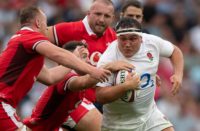 Isn't it strange with all the fuss re London Welsh not having a stadium that reached the minimum criteria and whether they needed primacy of tenure at their shared ground, the Premiership runner's up, Saracens, have just announced that for at least half the season they will have no home at all!
Isn't it strange with all the fuss re London Welsh not having a stadium that reached the minimum criteria and whether they needed primacy of tenure at their shared ground, the Premiership runner's up, Saracens, have just announced that for at least half the season they will have no home at all!
As a sometimes Saracens fan I must admit to being just a bit happy they will be moving out of Watford football club, a soulless place not suited to rugby at all.
The Copthall stadium will be a purpose-built venue that should at last give Sarries fans the home they have dreamed of – even if it is a little small with a capacity of just 10,000.
It is slightly awkward to reach with the nearest underground station (Mill Hill East) around two miles away and it's in the middle of park land which it shares with two other rugby clubs – Hendon and co-owner Nigel Wray's old boys, Mill Hill.
The capacity of 10,000 is a bit of a worry as a calculation done some time ago by the old manager of Saracens (Mark Evans), suggested that for any club to break even let alone make a profit they would need to have gates of around 12,000 across the season, a figure that many in the Premiership have yet to reach.
It does seem strange that a club with the obvious ambitions of Saracens would build a stadium with such a limited capacity, unless there were building restrictions limiting the size of stadium which could also stop any future expansion.
It may be that Saracens are happy to have a number of spectaculars per season to help balance the books but that could be a risky strategy should they fail to maintain their high-flying league position and not get enough transient support through the doors.
Another risk Sarries are taking is the installation of an artificial pitch as their playing surface at the new stadium.
If I am right they will be the only senior rugby club in the world playing on an artificial surface and that could open the door to a number of possible problems.
The idea of playing on a synthetic pitch is not new, Wasps tried it when they moved to Loftus road in their ground-share with QPR, and Richmond also had a brief spell of playing on an artificial pitch. Even I have played on one in America.
There are many advantages of artificial pitches, they are not affected by weather or the number of games played on them and you can more or less guarantee the playing surface, ensuring that neither team have an excuse to ‘shut the game down' other than their collective weakness.
They are also ideal for training and Sevens – now an Olympic sport that may soon be the game's major attraction.
That said there also a number of disadvantages, the ball reacts differently to a natural surface so teams that have not trained or played on an artificial surface (Saracens already train on an artificial pitch at their Old Albanians training ground) would be disadvantaged and could ask that the games are moved to a ‘normal' pitch.
Players could suffer more injuries both minor and major and it is that potential for injury that most concerns me.
As the standard of pitch technology has improved the numbers of soft tissue injuries, torn ligaments, shoulder injuries etc have also increased.
The better the surface the better a boot grips the floor, so when a players is tackled instead of the surface of the pitch breaking, allowing the foot to slide through the mud, the pitch stay intact and the pressure is passed from the surface to the next weak spot – the player's joints.
Although there is a lot done nowadays to reduce the numbers of injuries by specific training routines to build muscle in the areas where certain injuries occur, it is not possible to increase the strength of the various ligament tissues that form the links at the joints.
As fitness and speed of the game increase there is a higher risk of injury at the tackle area where players try and ‘kill' the ball as well as stopping the opposition.
This involves a midriff /chest high tackle rather than the traditional low tackle, putting an extra strain on the joints of the legs and the bigger the players the bigger the impact so something has to give which used to be, and still sometimes is, the pitch – but an artificial surface would never ‘give'.
Then there is the issue of rebound injury when a player hits the ground. On a normal playing surface (usually a bit soft) the impacts are absorbed, dispersing much of the energy into the ground. In contrast, an artificial surface acts like a dry pitch and ‘rebounds' the impact back into the player increasing the risks of shoulder and other bone injuries.
I know a lot of people will say what about NFL/AFL, there are a lot of artificial pitches in that championship so why should rugby be different?
In American football players wear boots with no studs to aid joint protection, full body armour and kit that covers the whole body to help absorb the rebound impacts as the body hits the floor and stop the burns that are associated with artificial surfaces.
There have been some major technological innovations in artificial surfaces so hopefully Saracens will have consulted with their Premiership colleagues, doctors and insurers and have one of the best.


























